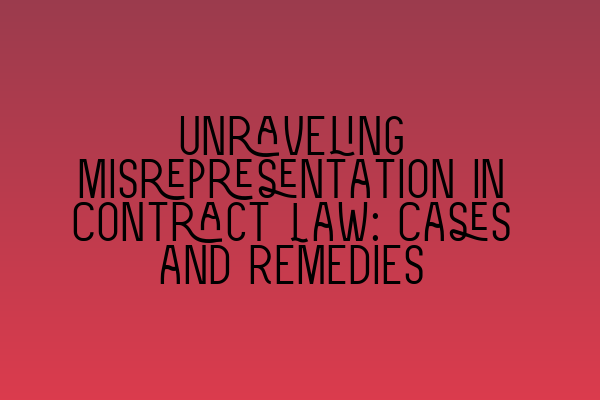Unraveling Misrepresentation in Contract Law: Cases and Remedies
In the realm of contract law, misrepresentation can be a complex and challenging issue to navigate. It involves a situation where one party makes false statements or conceals important facts with the intention of inducing the other party to enter into a contract. Unraveling misrepresentation cases requires a thorough understanding of the legal principles, relevant cases, and the available remedies. In this blog post, we will delve into the intricacies of misrepresentation in contract law, explore notable cases, and discuss the remedies available to aggrieved parties.
Understanding Misrepresentation in Contract Law
Misrepresentation occurs when one party makes a false statement of fact to the other party, inducing them to enter into a contract. The false statement can be made orally, in writing, or through conduct. Importantly, the false statement must be material – meaning that it would have influenced the decision of the other party to enter into the contract. In addition, the party making the false statement must have knowledge of its falsity or be reckless as to whether it is true or false.
There are three categories of misrepresentation: fraudulent misrepresentation, negligent misrepresentation, and innocent misrepresentation.
Fraudulent Misrepresentation
Fraudulent misrepresentation is the most serious form of misrepresentation. It occurs when a party makes a false statement with the knowledge that it is false or with reckless disregard for the truth. To succeed in a claim for fraudulent misrepresentation, the aggrieved party must prove that they justifiably relied on the false statement and suffered damages as a result.
A notable case that illustrates fraudulent misrepresentation is Derry v Peek [1889] UKHL 1. In this case, the directors of a tramway company made statements about the financial soundness of their business with the intention of inducing investors to purchase shares. However, the company had not yet obtained the necessary statutory authorization required for its operation. The House of Lords held that the directors were liable for fraudulent misrepresentation.
Negligent Misrepresentation
Negligent misrepresentation occurs when a party makes a false statement without exercising reasonable care in verifying its accuracy. The party making the false statement does not necessarily know that it is false but should have known with reasonable diligence. To establish a claim for negligent misrepresentation, the aggrieved party must demonstrate that they justifiably relied on the false statement and suffered damages as a result.
An example of negligent misrepresentation can be seen in the case of Hedley Byrne & Co Ltd v Heller & Partners Ltd [1964] AC 465. In this case, a bank provided a reference for a company without explicitly excluding liability. However, the reference was given negligently, leading the company to suffer financial loss. The House of Lords held that the bank was liable for negligent misrepresentation.
Innocent Misrepresentation
Innocent misrepresentation occurs when a party makes a false statement but genuinely believes it to be true. Unlike fraudulent and negligent misrepresentation, innocent misrepresentation does not require knowledge or reckless disregard for the truth. The aggrieved party can seek remedies such as rescission of the contract or damages, provided they can prove that they justifiably relied on the false statement.
Rescission and Damages as Remedies
When misrepresentation is established, the aggrieved party has a range of remedies available, including rescission and damages.
Rescission allows the aggrieved party to treat the contract as though it never existed. They can unwind the transaction and seek to be restored to their pre-contractual position. Rescission is an equitable remedy that aims to place the parties in the position they would have been in had the misrepresentation not occurred.
Damages, on the other hand, are a legal remedy available to compensate the aggrieved party for any financial loss suffered as a result of the misrepresentation. The damages awarded will vary depending on the nature and extent of the loss.
It is important to note that the remedies available may depend on the type of misrepresentation. In cases of innocent misrepresentation, rescission may be the preferred remedy, while for fraudulent or negligent misrepresentation, damages may be more appropriate.
Conclusion
Misrepresentation in contract law is a nuanced area that requires a keen understanding of the legal principles, relevant cases, and the available remedies. By unraveling misrepresentation cases, we have explored the different types of misrepresentation, notable cases that illustrate each type, and the remedies available to aggrieved parties. It is crucial for both solicitors and individuals involved in contract negotiations to be aware of their rights and obligations when it comes to misrepresentation.
To enhance your knowledge and prepare for the SQE exams, be sure to check out these related articles:
1. SQE 1 Practice Exam Questions
2. SQE 1 Practice Mocks FLK1 FLK2
3. SQE 2 Preparation Courses
4. SQE 1 Preparation Courses
5. SRA SQE Exam Dates
By staying informed and well-prepared, you can confidently navigate the intricacies of misrepresentation in contract law and ensure that your interests are protected.
